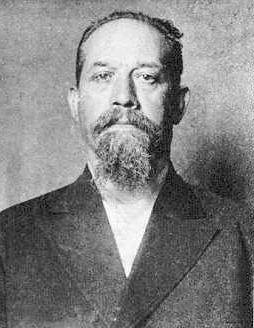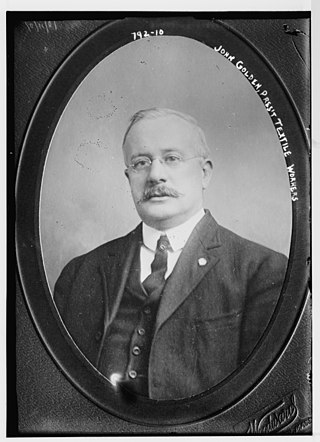
A strike of silk dyers in Paterson, New Jersey, from April to June 1902, spilled over into the wider New Jersey textile industry.

A strike of silk dyers in Paterson, New Jersey, from April to June 1902, spilled over into the wider New Jersey textile industry.
At the turn of the 20th century, Italians were the predominant immigrant nationality in Paterson's silk industry. The silk dyers' helpers, an unskilled trade, were mainly from southern Italy and formed the center of Paterson's Italian community. The silk dyers' militant tradition extended from the radical political tradition of immigrants from northern Italy. In the 1890s, Paterson was known as the international home of Italian anarchism. The Paterson Italian community was willing to defend itself against anti-Italian prejudices of the public and police, even if it meant resorting to violence. The community banded together through their conflicts with management and police. [1] Weavers had far more strikes than dye workers in the 1890s. As management could more easily replace and break the strike of unskilled dye workers, dye worker strikes tended to be bigger, such as the property destruction at the hands of dye workers in the 1894 ribbon weavers' strike. [2]
On April 23, 1902, a walkout of silk dyers in Paterson, New Jersey, started a strike. The strike targeted Paterson's two biggest dye firms, Jacob Weidmann and the National Silk Dyeing Company, both of whom opposed collective bargaining. [3] What began with twenty workers from two firms spread to gunshot injuries to three Italian workers and one policeman at one plant. [2] Smaller firms settled with the strikers. While the silk dyers supported each other, other silk industry workers did not support the strike and the industry's subcontracting to Pennsylvania factories mitigated its impact. The local newspaper Paterson Guardian supported the employers. [3]
Though the strike was waning by June, thousands of workers attended a rally on June 18 in Belmont Park, in Haledon, New Jersey, with speakers including Luigi Galleani, William MacQueen, and Rudolf Grossmann. The rally dissipated into riots in the Paterson mill district. In the police gunfire, Galleani was shot in the face and absconded to Canada. Paterson declared martial law and brought in the National Guard, ending both the riots and the strike. [3]
The strike was the Paterson's bloodiest. [1]

Paterson is the largest city in and the county seat of Passaic County, in the U.S. state of New Jersey. As of the 2020 United States census, the city was the state's third-most-populous municipality, with a population of 159,732.

The Lawrence Textile Strike, also known as the Bread and Roses Strike, was a strike of immigrant workers in Lawrence, Massachusetts, in 1912 led by the Industrial Workers of the World (IWW). Prompted by a two-hour pay cut corresponding to a new law shortening the workweek for women, the strike spread rapidly through the town, growing to more than twenty thousand workers and involving nearly every mill in Lawrence. On January 1, 1912, the Massachusetts government enforced a law that cut mill workers' hours in a single work week from 56 hours, to 54 hours. Ten days later, they found out that pay had been reduced along with the cut in hours.

Luigi Galleani was an Italian insurrectionary anarchist best known for his advocacy of "propaganda of the deed", a strategy of political assassinations and violent attacks.
Cronaca Sovversiva was an Italian-language, United States-based anarchist newspaper associated with Luigi Galleani from 1903 to 1920. It is one of the country's most significant anarchist periodicals.

The 1913 Paterson silk strike was a work stoppage involving silk mill workers in Paterson, New Jersey. The strike involved demands for establishment of an eight-hour day and improved working conditions. The strike began in February 1913, and ended five months later, on July 28. During the course of the strike, approximately 1,850 strikers were arrested, including Industrial Workers of the World (IWW) leaders Bill Haywood and Elizabeth Gurley Flynn.

The Pietro and Maria Botto House, also known as Pietro Botto House, at 83 Norwood Street, Haledon in Passaic County, New Jersey, United States, is where leaders of the Industrial Workers of the World (IWW) union spoke to the 25,000 striking workers of the Paterson Silk Strike of 1913.

The 1926 Passaic textile strike was a work stoppage by over 15,000 woolen mill workers in and around Passaic, New Jersey, over wage issues in several factories in the vicinity. Conducted in its initial phase by a "United Front Committee" organized by the Trade Union Educational League of the Workers (Communist) Party, the strike began on January 25, 1926, and officially ended only on March 1, 1927, when the final mill being picketed signed a contract with the striking workers. It was the first Communist-led work stoppage in the United States. The event was memorialized by a seven reel silent movie intended to generate sympathy and funds for the striking workers.

A silk mill is a factory that makes silk for garments using a process called silk throwing. Traditionally, silk mills were concentrated in Japan, England, New Jersey, Pennsylvania, Italy and Switzerland.
Maria Roda (1877–1958) was an Italian American anarchist-feminist activist, speaker and writer, who participated in the labor struggles among textile workers in Italy and the United States during the late 19th and early 20th centuries.

Arthur Patrick L. "Pat" Quinlan (1883–1948) was an Irish trade union organizer, journalist, and socialist political activist. Quinlan is best remembered for the part he played as an organizer for the Industrial Workers of the World in the 1913 Paterson silk strike — an event which led to his imprisonment for two years in the New Jersey State Penitentiary.
The United Textile Workers of America (UTW) was a North American trade union established in 1901.
The Cleveland Rolling Mill Company was a rolling steel mill in Cleveland, Ohio. It existed as an independent entity from 1863 to 1899.
Ninfa Baronio (1874-1969) was an Italian-American anarcha-feminist activist during the late 19th and early 20th centuries. After emigrating from Northern Italy to Paterson, New Jersey, she helped found Paterson's anarchist Gruppo Diritto all'Esistenza ; co-founded a local feminist group and performed in feminist plays; and, with her companion Firmino Gallo, ran an anarchist bookstore said to be "America's richest storehouse of extreme radical literature."

Rudolf Grossmann (1882–1942), known by his pseudonym Pierre Ramus, was an Austrian anarchist and pacifist.
The Lawrence Textile Strikes were part of a series industrial strikes in the garment and textile industries of the American East from 1909 to 1913. The participants of these strikes were largely immigrant factory workers from southern and eastern Europe. Class division, race, gender, and manufacturing expertise all caused internal dissension among the striking parties and this led many reformist intellectuals in the Northeast to question their effectiveness. A major turning point for these labor movements occurred in 1912 during the Lawrence Textile Strike in Lawrence, Massachusetts, where laborers were able to successfully pressure mill owners to raise wages, later galvanizing support from left-leaning intellectual groups. In 1913 the Paterson Silk Strike also referred to as the Lawrence Textile Strike of 1913 took place in Paterson, New Jersey. This strike was a work stoppage involving silk mill worker.

Galleanisti are followers or supporters of the insurrectionary anarchist Luigi Galleani, who operated most notably in the United States following his immigration to the country. The vast majority of Galleanisti or Galleanists were similarly poor and working class Italian immigrants or Italian Americans, and especially Italian anarchists and Italian immigrants or Italian-Americans involved in the labor movement of the time. Galleanists remain the primary suspects in a campaign of bombings between 1914 and 1920 in the United States.

John Golden was an American textile worker and trade union leader. He was elected president of the United Textile Workers of America (UTW) each year from 1902 until shortly before his death in 1921. At the time of his death, he was declared as important to textile unionism as John Mitchell was to mining unionism.

The Paterson pageant was a dramatic depiction of the 1913 Paterson silk strike acted by the strikers themselves in New York City's Madison Square Garden while the strike was ongoing. Staged by John Reed and other bohemians of Greenwich Village, the pageant played before a full audience and received positive reviews, though its public support and sympathy did not translate into success for the six-month strike, which crumbled following the pageant. One of the Wobbly leaders behind the strike, Elizabeth Gurley Flynn, credited the pageant with hastening strike's end, having split the strikers' attention from their primary cause.

Pincus Goodman, who published as P. Goodman, was an American Yiddish-language poet active from the 1920s to the 1940s. Because he worked as a silk weaver his whole life, he was known as the "weaver poet."

The 1912–1913 Little Falls textile strike was a labor strike involving workers at two textile mills in Little Falls, New York, United States. The strike began on October 9, 1912, as a spontaneous walkout of primarily immigrant mill workers at the Phoenix Knitting Mill following a reduction in pay, followed the next week by workers at the Gilbert Knitting Mill for the same reason. The strike, which grew to several hundred participants under the leadership of the Industrial Workers of the World (IWW), lasted until January the following year, when the mills and the strikers came to an agreement that brought the workers back to the mills on January 6.